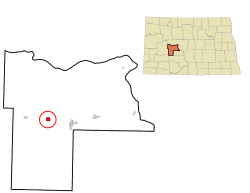2010 census
As of the census of 2010, there were 237 people, 109 households, and 70 families residing in the city. The population density was 225.7 inhabitants per square mile (87.1/km2). There were 135 housing units at an average density of 128.6 per square mile (49.7/km2). The racial makeup of the city was 91.6% White, 3.0% Native American, 1.3% Asian, and 4.2% from two or more races. Hispanic or Latino of any race were 0.4% of the population.
There were 109 households, of which 24.8% had children under the age of 18 living with them, 47.7% were married couples living together, 8.3% had a female householder with no husband present, 8.3% had a male householder with no wife present, and 35.8% were non-families. 31.2% of all households were made up of individuals, and 11% had someone living alone who was 65 years of age or older. The average household size was 2.17 and the average family size was 2.63.
The median age in the city was 49.1 years. 17.7% of residents were under the age of 18; 9.3% were between the ages of 18 and 24; 18.2% were from 25 to 44; 38.8% were from 45 to 64; and 16% were 65 years of age or older. The gender makeup of the city was 54.0% male and 46.0% female.
2000 census
As of the census of 2000, there were 231 people, 101 households, and 68 families residing in the city. The population density was 221.8 inhabitants per square mile (85.6/km2). There were 129 housing units at an average density of 123.8 per square mile (47.8/km2). The racial makeup of the city was 95.24% White, 3.90% Native American, and 0.87% from two or more races.
There were 101 households, out of which 25.7% had children under the age of 18 living with them, 60.4% were married couples living together, 4.0% had a female householder with no husband present, and 31.7% were non-families. 29.7% of all households were made up of individuals, and 14.9% had someone living alone who was 65 years of age or older. The average household size was 2.29 and the average family size was 2.78.
In the city, the population was spread out, with 21.6% under the age of 18, 5.2% from 18 to 24, 25.5% from 25 to 44, 33.3% from 45 to 64, and 14.3% who were 65 years of age or older. The median age was 44 years. For every 100 females, there were 100.9 males. For every 100 females age 18 and over, there were 92.6 males.
The median income for a household in the city was $30,536, and the median income for a family was $34,063. Males had a median income of $30,625 versus $18,125 for females. The per capita income for the city was $16,175. About 5.2% of families and 10.9% of the population were below the poverty line, including 18.6% of those under the age of eighteen and 18.2% of those 65 or over.



